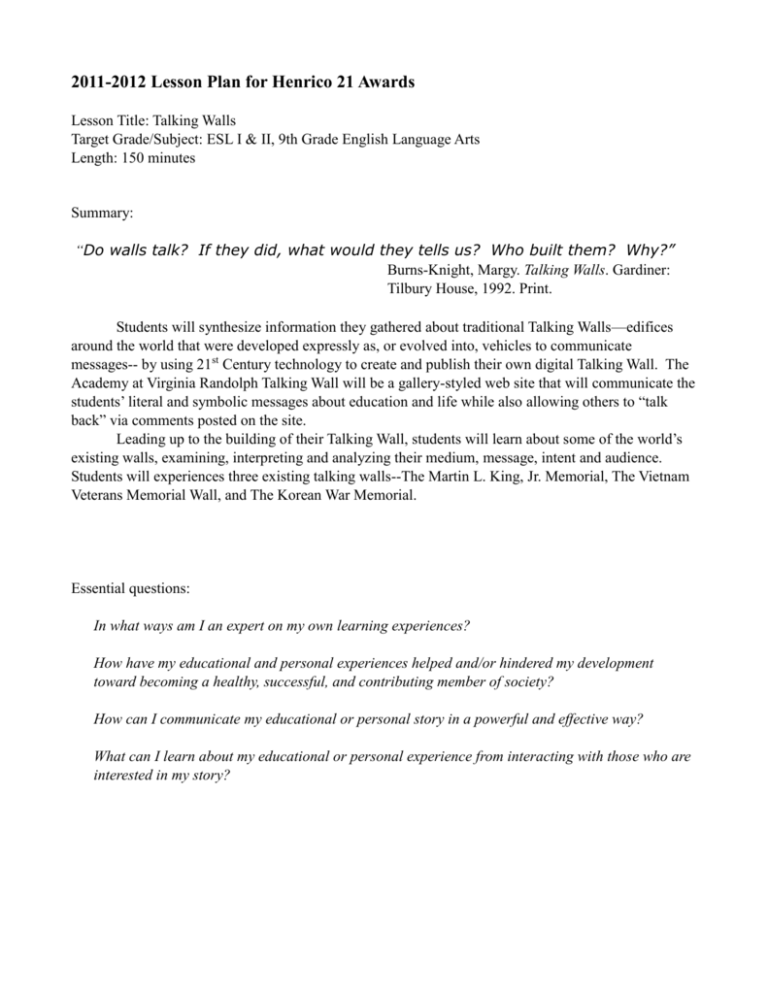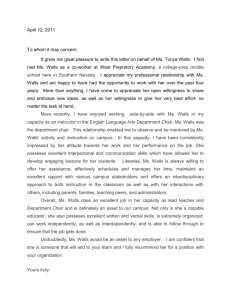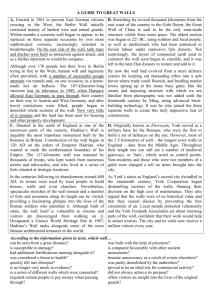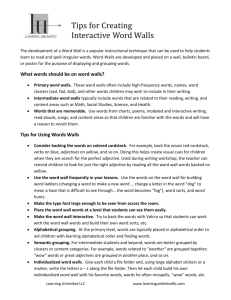Lesson Plan
advertisement

2011-2012 Lesson Plan for Henrico 21 Awards Lesson Title: Talking Walls Target Grade/Subject: ESL I & II, 9th Grade English Language Arts Length: 150 minutes Summary: “Do walls talk? If they did, what would they tells us? Who built them? Why?” Burns-Knight, Margy. Talking Walls. Gardiner: Tilbury House, 1992. Print. Students will synthesize information they gathered about traditional Talking Walls—edifices around the world that were developed expressly as, or evolved into, vehicles to communicate messages-- by using 21st Century technology to create and publish their own digital Talking Wall. The Academy at Virginia Randolph Talking Wall will be a gallery-styled web site that will communicate the students’ literal and symbolic messages about education and life while also allowing others to “talk back” via comments posted on the site. Leading up to the building of their Talking Wall, students will learn about some of the world’s existing walls, examining, interpreting and analyzing their medium, message, intent and audience. Students will experiences three existing talking walls--The Martin L. King, Jr. Memorial, The Vietnam Veterans Memorial Wall, and The Korean War Memorial. Essential questions: In what ways am I an expert on my own learning experiences? How have my educational and personal experiences helped and/or hindered my development toward becoming a healthy, successful, and contributing member of society? How can I communicate my educational or personal story in a powerful and effective way? What can I learn about my educational or personal experience from interacting with those who are interested in my story? Lesson Development: Students visited Washington D.C. and took part in a guided tour of three famous Talking Walls: The Martin L. King, Jr. Memorial, The Vietnam Veterans Memorial Wall, and The Korean War Memorial. This research served as an introduction to the lesson and provided background knowledge. Day 1 Students read and discuss a short essay based on Margy Burns Knight’s book, Talking Walls. Students use the Internet to research traditional talking walls. Using ActivInspire on the Promethean board, the teacher models the steps to conceiving, creating, posting, and communicating with others via a talking wall. ● The teacher presents her own story/message about her educational experience. ● The teacher presents this story using several different genres and mediums. ● The teacher demonstrates a mock talking wall entry of her story/message created in a WordPress portfolio-themed blog post. ● Students use their own laptops to access the web site to comment on the teacher’s message as the teacher responds in real time. ● The teacher navigates through the dashboard and public views of the web site to introduce the students to the process and final product of the virtual talking wall. Students create their own talking wall with the following steps: Step 1: After reviewing the essential questions, the teacher directs the students to recall two or three of their favorite classroom/school related experiences, and two or three of their least favorite classroom/school related experiences. ESL students are also asked to recall immigration or other personal experiences. Day 2 Step 2: Students decide on a story or message to relate via the wall. Step 3: Students decide on a genre/medium to use (poetry, song, video, picture, collage, or letter.) Step 4: Students collaborate in person as well as via Server Shortcuts Share to use various technologies (digital imaging, video recorder, PowerPoint slide, Audacity-created MP3s, etc.) to create a draft of their message for teacher approval and a plan for uploading the message to the wall. Day 3 Step 5: Students work on the final draft of message. Students will use Photoshop Elements 8 to resize, create captions, stylize and optimize jpegs and gifs for the web. Students will upload their messages to the Talking Wall website. The Academy at Virginia Randolph Talking Wall can be viewed at http://blogs.henrico.k12.va.us/talkingwalls/ Assessment: Students will be evaluated based on a rubric. On-going: Step 7: Students monitor the wall, posting and responding to comments. Step 8: Students write a reflection of their experience building and interacting with the outside world via the talking wall. TIP Chart Assessment: (Using the TIP Chart, identify which level and write a brief statement to describe what the students are doing as it relates to the indicators on the TIP chart.) Categories: Research and Information Fluency: (Approaching Competency)—Students selected the tools that would best help them to communicate their individual message on the Talking Wall Communication and Collaboration: (Approaching Competency)—Students use comments on the wall blog to communicate with pre-service teachers, university professors, members of the community, and other students Critical Thinking and Problem Solving: (Approaching Competency)—Students decided how to best create and communicate their message using digital technology. Creativity and Innovation: Approaching: (Approaching Competency)—Students created their own meaningful and original messages to be posted on the wall.








